Nature Conservation 2023 — 5. 6. 2023 — Special Issue — Print article in pdf
Hundred-year History of Nature Conservation Legislation in the Czech Republic
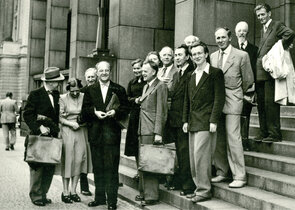
Thirty-year anniversary of the current Act on Nature Conservation and Landscape Protection is enhanced by an even older anniversary. In 2022, a century has passed since submitting the very first proposal for nature conservation act by the Member of the National Assembly of Czechoslovakia Jaroslav V. Stejskal. Therefore, let us briefly remember efforts by nature conservationists and naturalists to obtain legislative nature conservation and landscape protection in former Czechoslovakia, then the Czech Republic.
Efforts in the early 20th century
After previous individual efforts carried out by enlightened educated land owners to protect and conserve valuable natural monuments (PROCHÁZKA 1917, 1926, MAXIMOVIČ 1934, etc.) first attempts for systematic legislative nature conservation appeared at the turn of the 19th and 20th century. In 1894, in proposal of an act on art and historical monument/sight protection in the Austro-Hungarian Empire, there was a willingness to consider also natural monuments as the public interest.
In 1901, G. Nowak had submitted at House of Deputies in Vienna a proposal for an act on protection and conservation of natural monuments (MAXIMOVIČ 1956). The regulation of the Royal Hungarian Minister of Agriculture Daranyi of 1900 on veteran/memorial tree census and on mandatory protection of natural monuments of scientific and artistic importance issued in 1902 was probably an incentive for activity of the Vienna Ministry of Culture to begin elaboration of natural monument census and protection (MAXIMOVIČ 1942). In the same year, the Imperial-Royal Bohemian Stateholder´s Chancellery in Prague issued a circular assigning elaboration of a natural monument census. In the activity, also schools were involved. In 1902 Dr Bachmann MP submitted to the Bohemian Land Diet a proposal for preservation of natural and historical monuments in the Kingdom of Bohemia. As an example, two threatened natural monuments, namely Kamenická Hůrka near the town of Františkovy Lázně and Vysoký kámen/High Stone near the town of Kraslice, were presented by the MP. Consequently in 1903 the Vienna Ministry of Worship and Education had issued a regulation on natural monument protection for scientific and aesthetical reasons assigning to make a list of them and recommending to establish nature reserves there (MAXIMOVIČ 1956). The regulation was implemented by individual territorial authorities; moreover, elaborating more comprehensive list was interrupted by World War II. In 1907, forester Dimitz drafted relatively comprehensive principles of nature conservation legislation: he had been inspired by the definition of natural monument included in the then new law of Hesse and that of Hugo Conwentz (MAXIMOVIČ 1942).
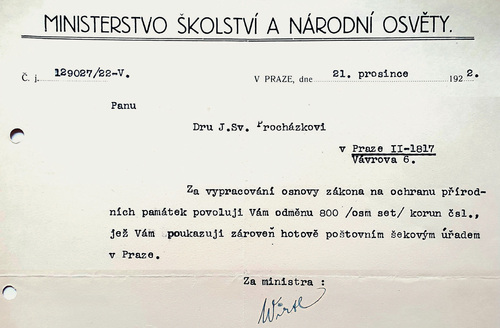
Official letter made by Z. Winter from the Ministry of Education and National Enlightenment (MENE) in 1922 ordering a financial bonus to Jan Sv. Procházka for developing a proposal of the act on monuments, namely a part dealing with natural monuments. © National Museum Archive Prague, copied by Pavel Pešout
Member of the Bohemian Land Diet Luboš Jeřábek had advocated nature conservation and landscape protection legislation: later he established and directed the State Heritage Office. Just during the first year of his election, i.e. in 1908, he submitted an outline of natural and landscape monument protection law (PEŠOUT 2014). When Commission for Preserving Monuments was established thanks to impetus from the Association for Embellishment on 21 December 1910 aiming, inter alia, at advocating their protection, L. Jeřábek became its leading person (PROCHÁZKA 1927). On 20 September 1911 he again submitted a proposal for nature conservation legislation (PROCHÁZKA 1917). During the last session of the Bohemian Land Diet in 1911, he submitted the very first proposal to establish protected areas within the Kingdom of Bohemia with the following resolution: the Bohemian Land Diet is assigned to … as soon as possible and funded by the Land to establish National Parks or protected areas for wildlife at suitable sites in typical landscapes in the vicinity of the Royal Capital of Prague (Šárka, Strahov quarries) as well at suitable sites in landscapes in mountains of the Kingdom (the Šumava/Bohemian Forest Mts., Pláně pod Roklanem/Plains under Mt. Roklan, Mt. Boubín, the Rudohoří/Ore Mts., the Krkonoše/Giant Mts., the Středohoří/Central Bohemia Uplands, Mt. Milešovka, Sutomská hora Hill, in the Brdy Highlands, in the vicinity of Padrť Fishponds, Mt. Blaník, Zelená Hora/Green Hill), through agreements with land owners according to the appropriate Land regulations: written after careful discussion with authorities and experts from both nations in the Land…(PROCHÁZKA 1927). The proposal was based on activities of the Union of Czech Associations for Embellishment in the Kingdom of Bohemia (MAXIMOVIČ 1934).
Period of the First Czechoslovak Republic
After 1918 intensive efforts to pass nature conservation legislation were continuing. With engagement of Jiří Janda, ornithologist and then the first Director of Prague Zoo, a proposal of a law on conservation of birds, particularly the Common nightingale, and on establishment of bird rescue centres was developed (PEŠOUT 2015). Moreover, it was only drafted. In 1919, the Ministry of Education and National Enlightenment (MENE) gathered background information for nature conservation legislation. Rudolf Korb, Jiří Janda, Jan Roubal and Karel Zimmermann sent their suggestions (MAXIMOVIČ 1956, PEŠOUT 2015, PEŠOUT 2021a).
In 1922, the very first comprehensive proposal for nature monument protection act was submitted by Jaroslav V. Stejskal, the Member of the National Assembly of Czechoslovakia, and 22 other MPs. Unfortunately, the proposal was finally brushed aside. It was also because the MENE itself intended to develop a draft dealing with protection of both cultural and natural monuments together (KLIKA 1946). The MENE did not recommend to separate natural monument protection and histori-cal and art monument protection and criticised also terminology used there. In addition, neither the Union of Czech Associations for Embellishment supported the proposal as evidenced by a speech of Z. Wirth on the congress of Czechoslovak botanists in 1921 when he stated that such an important piece of legislation cannot be produced in a hurry if “we were not able to manage it during the Austro-Hungarian Monarchy… we can some years to wait for it in the best interest of its quality.” He planned to elaborate a monumental very detailed law which cannot be found in any neighbouring countries (ANONYMUS 1921).
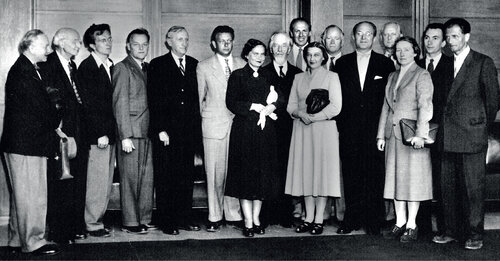
Nature conservationists who watched passing Act No. 40/1956 Gazette on State Nature Conservancy were snapped in a corridor of the National Assembly Prague. From left to right: Ludvík Kuba, Karel Vlach, Otakar Leiský,?, Pavel Neuman, Jan Tříska, Marie Maršáková, Rudolf Maximovič, Viktor Pleva, Marta Jarošová, Ladislav Kamarád, Jaroslav Veselý, Miroslav Burian, Věra Vildová, Zdeněk Vulterin and Valentin Pospíšil. © Nature Conservation Agency of the Czech Republic Archive
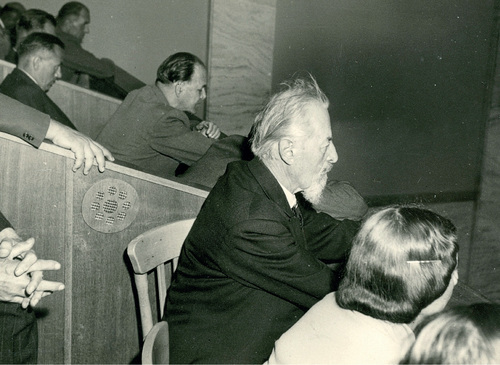
Rudolf Maximovič watching from a balcony a debate on the act on State Nature Conservancy at the National Assembly Prague, 1 August 1956. © Jan Tříska
In 1922, the MENE (Z. Wirth) officially asked historiographer J. Emler and Jan S. Procházka, the first university teacher on nature conservation in Czechoslovakia for developing a proposal for an act on monuments. The proposal partially respected then a new holistic approach to nature conservation and took into account experience from abroad, e.g. nature conservation legislation in the U. S. A. A part of the act dealing with nature conservation Procházka consulted with many other experts. For instance, 8 March 1922 he organised a meeting of the Committee for Scientific and Agricultural Nature Conservation aiming at developing a nature monument conservation act and related issues and where also representatives of the Czech Botanical Society and Natural History Club of the Czechoslovak Tourists participated in (PEŠOUT 2021b). At the same time, they submitted a proposal for statutes allowing declaration and management of national parks and nature reserves as well as a proposal for statutes of the State Heritage Office, Natural Science Section aiming exclusively at nature conservation (VESELÝ 1954). The timeless draft of the law became a background for further legislation proposals, e.g. that by Jan Dvořák, Ministerial Executive Administrator in 1924: although some of them had been debated within the inter-sectoral procedure but their debate by MPS was permanently postponed.
In 1926 Jan S. Procházka criticized permanent postponing the law and stated that it would have better to debate Stejskal´s proposal despite of its gaps, loopholes and shortcomings if the official draft has been postponed for such a long time (PROCHÁZKA 1926). In 1931, there was a proposal of an act on natural, historical and art monument protection made by J. Wirth, in 1937 – 1938 a proposal of outline of an act submitted by V. Paleček of 1934 was even debated within the inter-sectoral procedure. Moreover, by the beginning of World War II none of the proposals was passed and implemented. Officials participating in the respective meetings admitted necessity to protect monuments and nature by a piece of legislation, but they were afraid of declaring nature conservation as a public interest and of impacting private rights of individuals, because this, monument protection and nature conservation should became unpopular among the general public: therefore, they should be kept or shifted to private activities (MAXIMOVIČ 1956). All efforts to pass the act were terminated by breakup of Czechoslovakia and by German occupation.
Thus, during the First Czechoslovak Republic only partial legislative measures on natural monument protection were adopted, e.g. Article 8 of Act No. 438/1919 Gazette on State Subsidy to Systematic Electrification stating powerlines should respect the beauty of natural, landscape and historic monuments and art building and reducing trees is acceptable only in extent which is needed to build and manage distribution network. Or in Article 3 of Act No. 100/1921 Gazette on Building stated that for building purposes mature orchards should not be appropriated. Act No. 127/1927 Gazette on Political Administration Structure authorized political autho-rities to issue specific regulations on protecting public interests: when applying them, many muni-cipality offices (e.g. Jilemnice, Kolín, Louny, Mladá Boleslav, Praha, etc.) issued local regulations to protect rare wild plants and animals. Furthermore, Act No. 177/1927 Gazette on Cadastral Register and its Administration ordered to list any natural or other monument if it is located on the respective plot and when carrying out the procedure for establishing or renewing the cadastral register, an expert from the relevant department of monuments should be invited (KLIKA 1946).
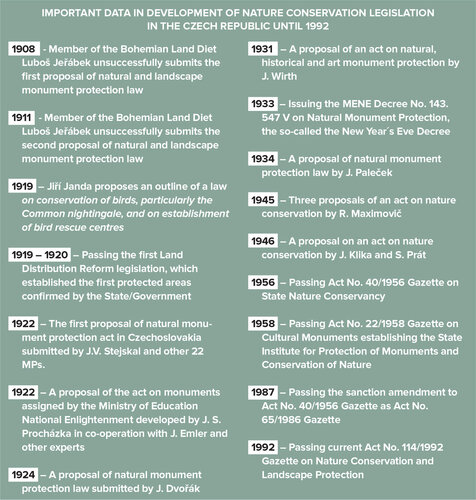
Because of lack of a nature conservation act, during the First Czechoslovak Republic protected areas could be declared only after they had been agreed the respective land owner, particularly when implementing the land distribution reform. Within the land distribution reform implemented particularly through three laws, namely the so-called Appropriation Act of 1919, Allocation Act and Redress Act of 1920, it was possible to order to current or new landowner specific conditions for management at the given property to preserve and protect a natural monument. Specifically Article 20 of the Allotment Act explicitly states as follows: When planning, the Land Office should avoid to disturb natural beauties and landscape character/scenery as well as natural, historical and art monuments. The Land Office can agree that sites/areas dedicated to parks, nature parks enhancing the beauty of the landscape or those aiming at preserving an example of the original landscape character/scenery or at preservation and protection of historical monument and their vicinity close related to them will be left to the current owner if the land owner accepts the conditions set by the Land Office after agreement with the ministries involved, if the land plots will be accessible to the general public, scientists, artists or will be used for charitable or philanthropic purposes.
The then nature conservation community realized that the Land Office had been very powerful. For instance, the above L. Jeřábek called the legislation rare and welcome opportunity for establishing protected area network by activities of the State also not only by efforts of enlightened educated land owners as it had been until then common in Czech lands. According to his opinion, the network should be established by declaring a certain number of national parks and larger nature reserves extensive enough to support undisturbed development and life cycle independent of the current one, by establishing as many as possible less strictly protected forest reserves following the U. S. experience and by as many as possible lesser protected areas for habitats of important flora, fauna and remarkable geological formations. As early as in 1920 he proposed and published a protected area network concept based on the previous draft from 1911 (JEŘÁBEK 1920, PEŠOUT 2014). Rudolf Maximovič the then General Conservator (Head of the State Nature Conservancy) considered the Land Distribution Reform legislation as the first generous nature conservation measure in the Czechoslovak legislation. As a result, there was a disappointment because the Land Distribution Reform impleentation itself became a subject of interest of many political parties and was carried out through various deals (MAXIMOVIČ 1956, STEJSKAL 2006).
In connection with territorial protection, it is necessary to mention the MENE Decree of 31 December 1933, the so-called the New Year´s Eve Decree prepared by R. Maximovič. Although the New Year´s Eve Decree was “only” an official list of protected areas existing at the time of its issuing and aiming at informing teacher community for teaching the topic, it is an important step in territorial protection on the Czech Republic´s territory. In the single act all protected areas which had been until then declared were listed: in addition, clearly a few more which were under preparation at that time were included there. Because the list was issued by the highest State Nature conservancy authority in the country, i.e. the MENE, thus confirming the existence of the protected areas (the individual decrees establishing the respective protected areas had been only uneasily retrievable), the New Year´s Eve Decree has been consequently quoted as a declaration decree (cf. e.g. MARŠÁKOVÁ-NĚMEJCOVÁ 1956, KOS & MARŠÁKOVÁ 1997). All up to now preserved areas listed on the New Year´s Eve Decree have been re-gazetted or are protected in other ways. The New Year´s Eve Decree had for decades contributed to protection, conservation and management of a significant part of the from a point of view of natural sciences most valuable areas in the Czech Republicand we have it to thank for their preservation (PEŠOUT 2013).
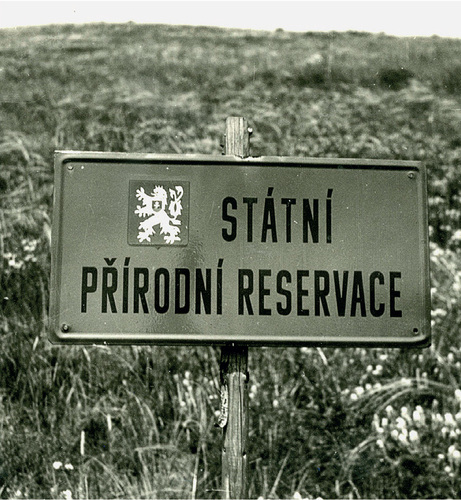
A boundary table of a State Nature Reserve used in the middle of the 20th century. Picture was taken in the then Tobiášův vrch/Tobias´ Hill State Nature Reserve, now Nature Monument of the same name, in 1969. © Jan Tříska
Period of the Second Czechoslovak Republic and Protectorate of Bohemia and Moravia
Procedures related to an act on monuments had convinced staff of the central authorities of necessity to separate nature conservation and monument/heritage preservation but everything was changed by occupation by Nazis and breaking away the borderlands. All measures adopted in the Protectorate of Bohemia and Moravia were checked and approved by occupiers, they had to be developed according to the Third Reich´s rules and was in accordance with Nazi ideology. Although even in this period attempts to develop nature conservation legislation were continuing and particularly due to efforts by R. Maximovič, some proposals of governmental decrees on nature conservation and landscape protection appeared in 1940 - 1943: thus, nature conservation legislation outline was developed in 1943 (MAXIMOVIČ 1956). For the Sudetenland after its annexation to the Third Reich till the Liberation and restoration of Czechoslovakia the Reich´s Nature Conservation Act of 1935 was in force (MAXIMOVIČ 1939a, 1939b, 1939c).
Period of the Third Czechoslovak Republic
Just in 1945, R. Maximovič as the elected revolutionary leader of Department of Forest Policy at the Ministry of Agriculture had submitted an outline of act on nature conservation in Czechoslovakia and after moving nature conservation to the Ministry of Education he submitted the act´s amended draft again. At the turn of 1945 and 1946, the Commission for Nature Conservation (from 1946 the Institute for Nature Conservation and Landscape Protection) at the First Section of Medical and Natural Science of the Masaryk Academy of Labour led by Jaromír Klika had elaborated a detailed proposal of a new nature conservation act, for the first time with differentiation between protective and creative (naturalization of the landscape) nature conservation and landscape protection (KLIKA 1947, PEŠOUT 2019b). Nevertheless, due to its complexity it was recommended to remake the proposal and to divide it to the act itself and implementation rules (MAXIMOVIČ 1947, VESELÝ 1954).
The Act on National Cultural Commissions for State Cultural Property Management of 1946 should also be mentioned: pursuant to it, plots having natural monument or natural reserve cha-racter had to be considered as the State Cultural Property (MAXIMOVIČ 1956).
Period of the Communist Regime
Neither after World War II nature conservation legislation was passed. Therefore, the main legislative pillars were the Constitution of 1950 highlighting cultural monument protection, the Administrative Criminal Code of the same year, which included also nature conservation and landscape protection, particularly natural monuments and natural reserves, as well as the act on afforestation/reforestation of 1948 explicitly setting down that natural beauties and monuments should be taken into account during its implementation.
Czech professional and non-governmental nature conservationists had to wait to 1 August 1956 when the National Assembly unanimously passed Act No. 40/1956 Gazette on State Nature Conservancy. Passing the act had been preceded by drafting a proposal and persistent efforts carried out by Jaroslav Veselý, the first Director of the State Institute for Protection of Monuments and Conservation of Nature based in Prague (TOMAN & TOMANOVÁ 1976, TŘÍSKA 1986). Czech conservationists were inspired not only by various earlier proposals but also by the Polish law that had been then in force. The Act was in force until 1 June 1992 when was replaced by current Act No. 114/1992 Gazette on Nature Conservation and Landscape Protection. Thus, the former was in force 36 years; there were surprisingly made only five amendments to it. The most significant change was the so-called sanction amendment, namely Act No. 65/1986 adding two articles on offences and possibility to impose sanctions/penalties and remedial actions (FRIEDL & DAMOHORSKÝ 1987). The Act was definitely a great factual and legal moment because it created a strong legal framework playing a key role in forming the modern nature conservation on the Czech Republic´s territory (DAMOHORSKÝ 2006).
In the 1980s, activities on amendments to the Act on State Nature Conservancy had begun. After November 1989, when great political, economic and social changes in former Czechoslovakia started, the State Nature Conservancy could prepare quickly a proposal of a new up-to-date legislation in nature conservation and landscape protection, i.e. Act No. 114/1992 Gazette on Nature Conservation and Landscape Protection.

